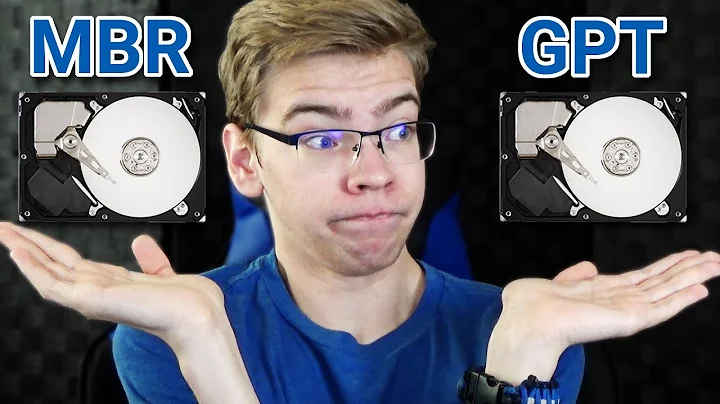GPT or MBR: How do I know?
Solution 1
You can use parted -l to determine the type of partition table. Eg:
$ sudo parted -l
Model: ATA TOSHIBA THNSNS25 (scsi)
Disk /dev/sda: 256GB
Sector size (logical/physical): 512B/512B
Partition Table: msdos
Number Start End Size Type File system Flags
1 4194kB 32.2GB 32.2GB primary ext4 boot
2 32.2GB 256GB 224GB primary ext4
Model: ATA Hitachi HDT72101 (scsi)
Disk /dev/sdb: 1000GB
Sector size (logical/physical): 512B/512B
Partition Table: msdos
Number Start End Size Type File system Flags
1 1049kB 32.2GB 32.2GB primary ext4 boot
2 32.2GB 996GB 964GB primary ext4
3 996GB 1000GB 4295MB primary linux-swap(v1)
The Partition Table field shows that I am using a msdos MBR partition table (the one still commonly used for Linux and Windows) on both disks. From the man page parted can create (and thus hopefully identify) the following types of partition table (or more broadly `disk label'):
bsd
dvh
gpt - this is a GPT partition table
loop - this is raw disk access without a partition table
mac
msdos - this is a standard MBR partition table
pc98
sun
Update
It is worth adding the command for listing a single partition since this is not obvious without some knowledge of parted and it can be a pain finding the data you need if there are multiple drives. For /dev/sda you would do:
parted /dev/sda print
Solution 2
On linux, you can check this via the gdisk tool which should be available for any distro.
gdisk -l /dev/sda
Here, /dev/sda is the device node of the physical drive, not a partition (/dev/sda1, /dev/sda2, etc. are partitions).
If you see something that includes:
***************************************************************
Found invalid GPT and valid MBR; converting MBR to GPT format
in memory.
***************************************************************
You have a MBR style disk. Don't worry, this did not do any harm.
If you don't see this warning, you have a GPT disk, or a hybrid GPT/MBR disk. The later are used mostly on Apple machines intended to dual-boot versions of MS Windows which do not support GPT. gdisk will indicate this with:
Found valid GPT with hybrid MBR; using GPT
They may also be used in other situations where support for both styles is required.
Solution 3
As the OS was not specified, here is FreeBSD way of doing things.
All is done through the gpart command (short for GEOM partioner - nothing to do with GNU).
A simple gpart show would show you all the available partitions of all the disks, but you can specify the device to have a more precise look on one:
-
legacy partition layout with MBR (aka "msdos") and BSD partition schemes (a 2-level partitioning was usually required for BSD systems, unless using the full disk):
$gpart show=> 63 67108801 ada0 MBR (32G) 63 67108545 1 freebsd [active] (32G) 67108608 256 - free - (128k) => 0 67108545 ada0s1 BSD (32G) 0 2097152 2 freebsd-swap (1.0G) 2097152 65011393 1 freebsd-ufs (31G) -
modern partition layout using GPT:
$gpart show /dev/ada2=> 34 976773101 ada2 GPT (465G) 34 6 - free - (3.0k) 40 128 1 freebsd-boot (64k) 168 67108864 2 freebsd-swap (32G) 67109032 901775360 3 freebsd-zfs (430G)
To know more, all is in the gpart manual.
Solution 4
Use
$ sudo fdisk -l
Disk /dev/sda: 119.2 GiB, 128035676160 bytes, 250069680 sectors
Units: sectors of 1 * 512 = 512 bytes
Sector size (logical/physical): 512 bytes / 512 bytes
I/O size (minimum/optimal): 512 bytes / 512 bytes
Disklabel type: dos
Disk identifier: 0x987c1a05
Device Boot Start End Sectors Size Id Type
/dev/sda1 * 2048 999423 997376 487M 83 Linux
/dev/sda2 1001470 250068991 249067522 118.8G 5 Extended
/dev/sda5 1001472 250068991 249067520 118.8G 8e Linux LVM
See the Disklabel type: dos. If it shows dos that means it is MBR schema else GPT schema
Solution 5
With udisks on Linux:
$ sudo /lib/udev/udisks-part-id /dev/sda
using device_file=/dev/sda syspath=/sys/devices/pci0000:00/0000:00:0b.0/ata1/host0/target0:0:0/0:0:0:0/block/sda, offset=0 ao=0 and number=0 for /dev/sda
Entering MS-DOS parser (offset=0, size=500107862016)
MSDOS_MAGIC found
found partition type 0xee => protective MBR for GPT
Exiting MS-DOS parser
Entering EFI GPT parser
GPT magic found
partition_entry_lba=2
num_entries=128
size_of_entry=128
Leaving EFI GPT parser
EFI GPT partition table detected
UDISKS_PARTITION_TABLE=1
UDISKS_PARTITION_TABLE_SCHEME=gpt
UDISKS_PARTITION_TABLE_COUNT=4
Above, I've got a drive with hybrid GPT+MS-DOS partitioning. In that case, the Linux kernel ignores the MS-DOS partitioning, which is why udisks sets UDISKS_PARTITION_TABLE_SCHEME to gpt.
That udisks-part-id tool is used to populate the udev database. So if you've got udisks installed, you should be able to query that information even as a non-priviledged user with:
$ udevadm info -q property -n sda | grep UDISKS_PARTITION_TABLE_SCHEME
UDISKS_PARTITION_TABLE_SCHEME=gpt
Related videos on Youtube
goldilocks
Gentleman programmer and linux enthusiast; raised by bears. o_O? "You are lost in the Real." (Baudrillard) http://cognitivedissonance.ca/cogware/
Updated on September 18, 2022Comments
-
 goldilocks almost 2 years
goldilocks almost 2 years-
Avinash Raj over 10 years
-
-
 Admin over 10 yearsIf not installed and not in a
Admin over 10 yearsIf not installed and not in agdiskpackage, it can be found in thegptfdiskpackage... at least on Gentoo. -
 goldilocks over 10 years@orion I would not recommend that as some versions of tools like
goldilocks over 10 years@orion I would not recommend that as some versions of tools likefdiskorcfdiskmay support GPT and therefore not show an error. -
 Tim over 10 yearsThat is a great command, Graeme. Although I've been using Linux for several years, I had never really noticed it. Thanks!
Tim over 10 yearsThat is a great command, Graeme. Although I've been using Linux for several years, I had never really noticed it. Thanks! -
Graeme over 10 yearsNote that you will get similar output regardless of whether there is a hybrid GPT+MBR or not. GPT requires a fake MBR with a single full disk partition of type
0xee. In a hybrid this is a normal MBR with one0xeepartition (and potential for major problems if the MBR data goes out of sync with the GPT data). -
Graeme over 10 yearsFor me
gdiskdetects a hybrid GPT+MBR partition table and givesFound valid GPT with hybrid MBR; using GPT.. This seems to be the only method which will detect a hybrid table. -
 goldilocks over 10 years@Graeme : Thanks. I was unaware of these (the original hybrid reference was edited in by Stephane Chazelas), but I did a bit of reading and added some details.
goldilocks over 10 years@Graeme : Thanks. I was unaware of these (the original hybrid reference was edited in by Stephane Chazelas), but I did a bit of reading and added some details. -
Jake Alsemgeest about 9 years
parted /dev/sda pwill do, too. -
Santropedro over 5 yearsi had to do "sudo parted -l"
-
agc over 5 yearsOn my Ubuntu 18.04 system
fdisk -l /dev/sda | grep -i disklabelreturns nothing, (GNU Fdisk 1.3.0a). -
Milan Babuškov over 3 yearsWhich blkid version is this? When I try with 2.17.0, it doesn't print anything for the whole disk, it only shows information for individual partitions.
-
Milan Babuškov over 3 yearsOn one of the CentOS systems where I tried this, it prints ID_PART_TABLE_TYPE=dos, so grep fails to find the line.
-
mivk over 3 years@MilanBabuškov : Indeed, version 2.27 in Ubuntu 16 doesn't show it. Version 2.33.1 in Debian 10 does show it.
-
piertoni almost 3 yearsshould be
Disklabel, not lowercasedisklabel, maybe this is the problem?




